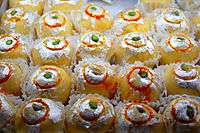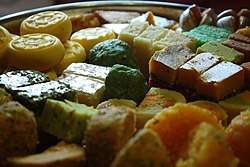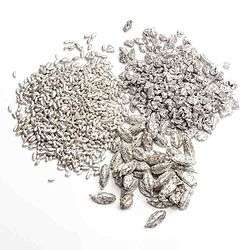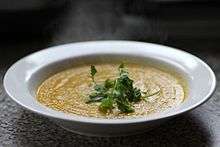Vark
Vark, also called varak (also silver leaf), is super fine filigree foil sheet of pure metals, typically silver but sometimes gold,[1] used to decorate South Asian sweets and food, but also placed on mounds of saffroned rice served on platters, to make those look more appetising.[2][3][4] The silver and gold are edible, though flavorless. Varak is made by pounding silver into sheets a few micrometres (μm) thick, typically 0.2 μm-0.8 μm. The silver sheets are typically packed between layers of paper for support; this paper is peeled away before use.[5] It is fragile and breaks into smaller pieces if handled with direct skin contact. Leaf that is 0.2 μm thick tends to adhere to skin if handled directly. Vark sheets are laid or rolled over some South Asian sweets, confectionery, dry fruits and spices.[6][2] For safety and ethical reasons, the government of India has issued food safety and product standards guidelines for manufacturers of silver foil.[7]
 Indian sweets garnished with vark | |
| Alternative names | Varq, vark, varak, varakh, varakha etc. |
|---|---|
| Type | Garnish |
| Place of origin | Indian Subcontinent |
| Region or state | South Asia |
| Main ingredients | Silver, Gold |
History
Etymology

Varaka means cloth, cloak or a thing that covers something else. Vark is sometimes spelled Varaq, varq, vark, varkh, varakh, varkha, or waraq (Hindi: वरक़, Urdu: ورق Hindi pronunciation: [ʋəɾəq]). In Persian, varaqa (borrowed from Arabic waraq), means a sheet, leaf or foil.
Origin
The tradition of using silver and gold foils to decorate food originated from the ancient Ayurvedic practice of using precious metals and pieces of pearl and conch shell in bhasma (medicinal ash).[3] Varaka is mentioned in several ancient Sanskrit documents, particularly in Ayurvedic and medical literature. The word varaka is mentioned with swarna (gold), tara (silver) or rupera (silver) in these documents; the discussion is in three forms of these precious metals: patra (leaf), varaka (thin foil) and bhasma (ash). Ayurvedic documents consider silver as an antimicrobial astringent, while gold is claimed to be an aphrodisiac. This is not unique to Indian subcontinent; in Europe, edible gold (Aureum potabile) and silver were also claimed to have medicinal properties; later studies found that they can indeed be antibacterial owing to the oligodynamic effect.
The Verk product

Manufacturing
Varak is made by placing the pure metal dust between parchment sheets, then pounding the sheets until the metal dust mold into a foil,[3] usually a few micrometres (μm) thick, typically 0.2 μm-0.8 μm. The sheets are typically packed with paper for support; this paper is peeled away before use.[1] it generally takes 2 hours to pound the silver particles into foils.[8]
Particles were traditionally manually pounded between the layers of ox gut or cow hide.[8] It is easier to separate the silver leaf from the animal tissue than to separate it from the paper. Due to the concerns of the vegetarian population of India, manufacturers have switched to the modern technologies that have evolved for the production of silver leaves in India, Germany, Russia and China.[1]Modern technologies include beating over sheets of black special treated paper or polyester sheets coated with food grade calcium powder (nicknamed "German plastic") are used instead of ox-guts or cow hide.[8] Old City in Hyderabad use to be the hub of traditional manual manufacturing, where it is a dying trade.[8] Modern machine based manufacturing hubs are based in Delhi and Noida.[8]
Usage as food
The silver is edible, though flavorless. It is also commonly used in Pakistan and India as coating on sweets, dry fruits (such as almonds, cashews, and dates), and in sugar balls, betel nuts, cardamom, and other spices.[2] Estimated consumption of Vark is 275 tons (according to BWC-Beauty without cruelty data) annually (c. 2016).[7]
Using edible silver and gold foils on sweets, confectionery and desserts is not unique to the Indian subcontinent; other regions such as Japan and Europe have long used precious metal foils as food cover and also decoration, including specialty drinks such as Danziger Goldwasser.[1]
Vegetarian ethical issues
Concerns have been raised about the ethical acceptability[8] and food safety of Vark, as not all of it is pure silver, nor hygienically prepared, and the foil nowadays commonly is beaten between layers of ox-gut because it is easier to separate the silver leaf from animal tissue than to separate it from paper.[7] Due to the grinding effect of the hammering, some of the animal intestine becomes part of the silver foil, which is sold in bulk.[9] Hindu and Jain religions are mostly vegetarian, this led to the decline in the usage of varq in sweets or suparis.[9] Indian Airlines asked its caterers to not apply varaq to the food supplied to ensure no animal intestine is present.[9] In 2016, Government of India banned the usage of animal guts or skins in the making of verk.[7] Consequently, the Indian market for Vark has mostly converted to using the machine-based vegetarian process in the making of the silver foils. This directive was halted in 2017 as a result of job loss concerns.[10] Food Safety and Standards Authority of India has issued guidelines for the silver leaf manufactures to adhere to regarding thickness, weight, purity, labeling and hygiene of the silver leaf.[7]
Safety
Gold and silver are approved food foils in the European Union, as E175 and E174 additives respectively. The independent European food-safety certification agency, TÜV Rheinland, has deemed gold leaf safe for consumption. Gold and silver leaf are also certified as kosher. These inert precious metal foils are not considered toxic to human beings nor to broader ecosystems.[11][12] Large quantities of ingested bioactive silver can cause argyria, but the use of edible silver or gold as vark is not considered harmful to the body, since the metal is in inert form (not ionic bioactive form), and the quantities involved in normal use are minuscule.[13]
One study has found that about 10% of 178 foils studied from the Lucknow (India) market were made of aluminium. Of the tested foils, 46% of the samples were found to have the desired purity requirement of 99.9% silver, whereas the rest had less than 99.9% silver. All the tested Indian foils contained on average trace levels of nickel (487 ppm), lead (301 ppm), copper (324 ppm), chromium (83 ppm), cadmium (97 ppm) and manganese (43 ppm). All of these are lower than natural anthropogenic exposures of these metals; the authors suggest there is a need to address a lack of purity standards in European Union and Indian food additive grade silver.[14][15] The total silver metal intake per kilogram of sweets eaten, from vark, is less than one milligram.[7]
References
- Gold in Gastronomy deLafee, Switzerland (2008)
- Vijaya Ghose, Jaya Ramanathan, and Renuka N. Khandekar, 1992, Tirtha, the Treasury of Indian Expressions, Page 61.
- Maya Tiwari, 2005, Ayurveda: A Life of Balance : the Complete Guide to Ayurvedic.
- 1989, The Illustrated Weekly of India, Volume 110, Issues 36-44 - Page 39.
- Madhu Gadia, 2000, New Indian Home Cooking: More Than 100 Delicious Nutritional, and Easy Low-fat recipes.
- DK, 2017, The Periodic Table Book: A Visual Encyclopedia of the Elements.
- Govt slogs its guts out for ‘vegetarian’ chandi ka vark, Daily Pioneer, 8 June 2016.
- ‘Chandi ka Warq’ business may become history soon, The Economic Times, 8 Jan 2018.
- Thanwardas Lilaram Vaswani, 1992, East and West Series, Issues 412-423, Page 10.
- "Delhi High Court stays order banning use of silver leaf made using animal material". Hindustan Times. 2017-09-23. Retrieved 2018-10-20.
- Conspicuous Consumption L.V. Anderson, Slate (July 16, 2012)
- Public Health Statement for Silver ATSDR-CDC, US Government (December 1990)
- Sarvate, Sarita (4 April 2005). "Silver Coating". India Currents. Archived from the original on 27 September 2007. Retrieved 2009-07-05.
- Das, Mukul; Dixit, S.; Khanna, S. K. (2005). "Justifying the need to prescribe limits for toxic metal contaminants in food-grade silver foils". Food Additives & Contaminants. 22 (12): 1219. doi:10.1080/02652030500215235.
- Agency for Toxic Substances and Disease Registry, See toxicity, food and exposure papers on nickel, lead, copper, chromium, cadmium and manganese.
